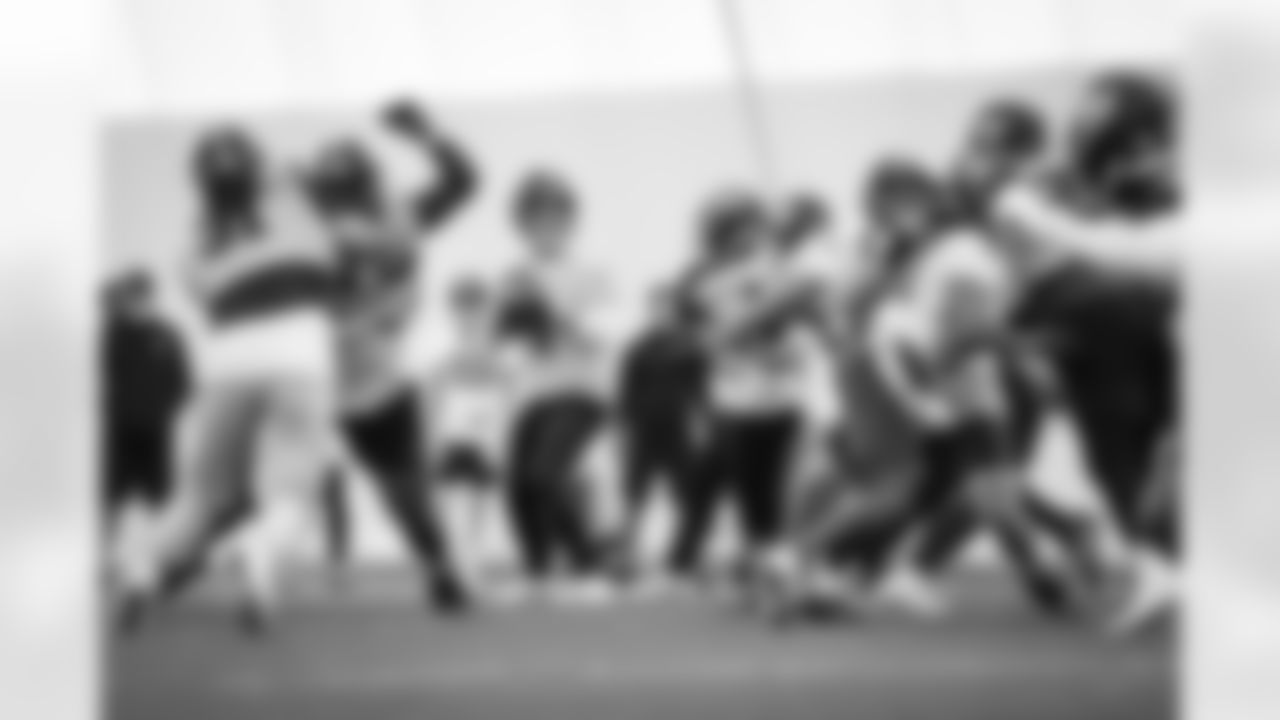The opinions expressed in this article do not reflect those of the team.
The Washington Commanders will take on the Philadelphia Eagles in an NFC East rematch on Monday Night Football. Here are three keys to securing the upset, presented by KIA.
1. What can Washington do to limit the Eagles' use of RPOs?
Logan: The goal of an RPO (run-pass option) is to use pre-snap and post-snap information to allow the quarterback an opportunity to get the offense into the most advantageous look.
The Eagles ran an RPO out of a three-by-one formation against Arizona with the tight end to the offensive right and the three receivers to the offensive left. Arizona started the play with six players allocated to stop the run: four defensive line men and two-line backers.
In this look, Philadelphia should run the football. They have six blockers plus the running back, while Arizona only had six defenders. However, Arizona rotated another player into the box on the snap. Jalen Hurts saw the late shift and threw a screen to Watkins that went for 12 yards. This is an example of how Philly uses the RPO to maximize their offense. The second Arizona allocated more resources to stopping the run, they placed themselves at a disadvantage when it came to stopping the pass.
To get this same type of flexibility, NFL offenses used to call two plays in the huddle. A run for the lighter box looks and a pass when the defense played the heavier run structures. This works well when defenses tip their hand, showing their coverage structures early.
However, when teams disguise coverages, the mechanics and the communication required to change the play become challenging to execute. This is where the RPO excels. The quarterback can see these late changes by the defense and make a quick decision to maximize the offense's efficiency, even if it is at the last moment.
Philadelphia also uses RPOs to put defenses in conflict post-snap. In Washington's first game against Philly, they did this at a high level. Philadelphia came out in a two tight end set with the receivers in close splits with the running back aligned to Hurts' right. On the snap, Hurts' eyes went to Montez Sweat. Sweat stepped down as if he is defending the run. Jalen pulled the ball and threw to Zach Pascal in the flat for a 15-yard completion.
The thing that makes Hurts special on this play is that his is also seeing safety rotation. Kam Curl was rotated down to the strong side, away from the back, and Bobby McCain was deep. The disguise by Jack Del Rio was awesome. He showed Hurts that if Sweat crashed down, there was no one left for him as a runner. However, McCain shifted down on the snap to account for Hurts. Hurts realized Washington is playing man coverage and avoided a bad look to run the ball into.
These examples show why the RPO is so dangerous. It lets the quarterback get the offense into the best situation on the fly. So, how does Washington slow him down? The high-level answer is simple. Confuse Hurts and win one on one matchups.
Del Rio should be commended for the first game. He ran basic coverages and fronts but was able to add enough new looks to disrupt Hurts early on his RPO reads. Obviously, Hurts is excellent in this area, so eliminating the RPO's completely won't be possible. However, if Del Rio can disrupt him a handful of times and force second and long situations, he gives the defense a chance to get off the field.
The next element is win one-on-ones. If the defensive line can win one-on-ones, it puts less pressure on Del Rio to call a perfect game. Jon Allen and Daron Payne have been playing out of this world, so I like Washington's chances.
Zach: I completely agree with Logan's point on confusing Hurts, but I want to drive home the point he also made about winning one-on-one matchups because of how they can disrupt a play even when Hurts makes the right read.
Take the first-and-10 at Philadelphia's 46-yard line as an example. Allen beat Landon Dickerson, immediately recognized that Hurts had the ball and rushed in the quarterback's face. That forced Hurts to get rid of the ball early and off target, resulting in an incompletion.
Another example came in the third quarter at the Commanders' 35-yard line. Allen swam past Sua Opeta and enveloped Miles Sanders for no gain.
Plays like this show that when defensive linemen win their matchups, it doesn't matter if Hurts makes the right decision. Granted, it will still be a challenge, but Washington showed that it can be disruptive enough to throw such a critical part of Philadelphia's offense off balance.
2. How can the Commanders have success against the Eagles' defensive front?
Logan: Washington struggled in their first outing against Philadelphia in large part because of their defensive front. I think the outcome will be different this time. Not only it is a matter of pride for Washington's offense, but I believe the absence of Jordan Davis will change the dynamic of the matchup.
Davis achieved infamy at the combine for being one of the largest and fastest prospects. Despite his historic combine performance, there were doubts about how effective he would be at the NFL level. This was due to his limited snap count in college, combined with production that didn't match his athletic traits. These doubts did not discourage Philadelphia from taking him in the first round.
There was some concern about his role within the Philadelphia defense, but the role has stayed much the same as it was during Davis' time at Georgia. He plays between 15-25 snaps on first and second down.
So, how does someone who plays sparingly impact the game so dramatically? Davis is a force on first and second down, eating double teams letting linebackers run free, and winning matchups when he is singled up with the center. This keeps teams out of favorable second down situations and limits what the defense must be prepared for.
For example, Washington runs an RPO on the second first down of the game. Davis beat the center, created a pressure and batted the ball down. The next two Philadelphia plays are set up by this success. The bring a blitz on second-an-10 and get a hit on Carson Wentz. Wentz does an excellent job completing the ball, but on third down, Josh Sweat beat Charles Leno for a sack. Davis doesn't make that play, but his performance on first down allowed Philadelphia's defense to change their approach and get more aggressive.
In Davis's absence last week, the Texans were able to average 5.3 yards per carry on 27 attempts. This helped keep Houston out of poor second and third down situations. Obviously, Philadelphia defense is still outstanding, but they could not be as aggressive as they were against Washington.
While Davis' impact on other teams is significant, the impact on his teammates might be his real contribution. When Philadelphia is in their five-man front, Fletcher Cox and Javon Hargrave are freed up to both play three techniques -- a position that lends itself to more single blocks and puts the players in a better position to defeat blocks and rush the passer.
Without Davis, Philadelphia's defense is still stacked, but his absence gives Washington an opportunity to attack the middle of their defense on first and second down. That could allow Washington to possess the football and take some pressure off Taylor Heinicke and its defense.
The Washington Commanders have finished their second day of practice to get themselves ready for their Monday Night Football matchup against the Philadelphia Eagles. Here are best photos from Friday. Photos by Emilee Fails and Kourtney Carroll/Washington Commanders










































































Zach: Logan did a great job of covering the run game, so I'll cover the passing game. Allowing nine sacks is tough, and that number is not completely on the offensive line. However, it will still be critical for the group to win their one-on-one matchups.
Let's look at the second sack of the game as an example. The pressure came from the offensive right with Cox bull rushing Trai Turner and Hasaan Reddick attacking the outside. Reddick forced Sam Cosmi to turn his shoulders, giving the defensive end a quicker path to the quarterback. The same thing happened to Turner, and while he was able to recover, he could not settle his feet and stop Cox's momentum, leading to the six-yard sack.
Adding to this frustration is the fact that Philadelphia hardly blitzed for the entire game.
Things have gotten better over the past three games for Washington with just six sacks in that span. Some of that is because of Heinicke's ability to extend plays with his legs, but it is also because the offensive line has been more consistent with their technique.
Philadelphia's front is dominant and will certainly make plays on Monday, but if Washington's offensive line can carry its improvements into Week 10, it could give Heinicke a sliver of extra time to get the ball to his playmakers.
3. What is one matchup to watch on Monday?
Logan: Jason Kelce looks out of place on Philadelphia's offensive line. His listed weight (295 pounds) seems like a college weight, but despite his relatively diminutive stature, he is a key cog in Philadelphia's run game.
Kelce's ability to get to second-level defenders is unparalleled. For example, most teams use a double team between the center and the play side guard to account for the linebacker to the front side of the run. This block is extremely challenging because the guard is usually out leveraged, meaning the linebacker is in an advantageous position to hold his gap and force the ball back to the other members of the defense.
Kelce is Philadelphia's ace in the hole. Not only is Kelce able to reach this frontside player with minimal help from the guard, but they also have an alternative that is just as effective. Instead of the guard having to reach the linebacker, they block down on the defensive lineman, who is usually lined up inside of them. Kelce then pulls, and his speed allows him to run around the guard and reach the play side linebacker, looking more like a fullback than a center.
His ability to catch and sustain this block in space allows Philadelphia to gain leverage to the front side of runs that most teams can't get. This is a huge advantage in Philadelphia's RPO, Outside zone and screen game.
This presents a challenge for Washington's linebackers and safeties. They will have to be outstanding with their reads because most teams can only achieve this advantage with a tight end or fullback. Not only will they mentally have to be dialed in, but they have to be ready to deal with a player who moves like a skill player and has the strength to mix it up with defensive linemen. It's always exciting to see how teams and players deal with unique skillsets, and I can't wait to see how Washington handles what Kelce brings.
















